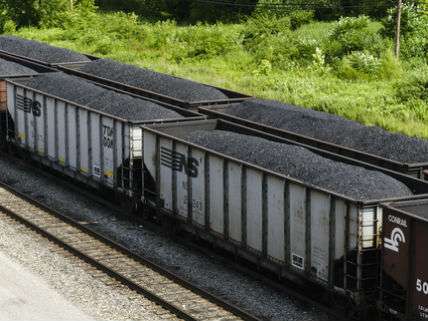Coal as 'Clean' as Natural Gas?
A renaissance for King Coal?

A Japanese company claims to have developed a new coal-burning technology that boosts coal's energy efficiency by 30 percent while reducing its carbon dioxide emissions by as much as 40 percent. Unlike conventional plants, which burn coal at around 700 degrees Celsius, the Osaka Coolgen plant roasts coal at more than 1,300 degrees Celsius while simultaneously blowing oxygen over it to convert the solid fuel into a gas. The plant also uses exhaust heat to generate power, and it extracts hydrogen from the gas to use in fuel cells to create electricity.
Using conventional technologies, burning enough bituminous coal to produce 1 million british thermal units (BTUs) emits 205 pounds of carbon dioxide. If the new technology reduces carbon dioxide emissions by 40 percent, that would cut emissions to roughly 123 pounds. Getting the same energy yield from natural gas emits 117 pounds of carbon dioxide.
Last year the electricity generated from natural gas accounted for the largest share of total U.S. electric power generation (33.8 percent), surpassing coal's share (30.4 percent) for the first time ever. In fact, America's electric power sector burned 677 million tons of coal in 2016, the lowest amount since 1984.
Meanwhile, the American price of coal per million BTUs has recently fallen below that of natural gas. Could this new technology spark a resurgence of coal mining and a boost in employment for miners?
Probably not for now. Osaka Coolgen estimates that its new plants would cost 20 percent more to build than conventional coal-fired facilities. In the United States, the levelized cost for conventional coal plants ranges between $60 to $143 per megawatt/hour; for gas combined cycle plants, by contrast, the range is $48 to $78. Given these costs, power generation companies are unlikely to build new coal-fired plants in the U.S. using the new Japanese technology.
Coal mining productivity rose from 1.93 tons per miner-hour in 1980 to 6.28 short tons per miner-hour in 2015. Thanks largely to automation, employment in the industry fell from 242,000 in 1980 to 102,000 in 2015. So even if demand for coal increases, the effect of on mining employment in the U.S. would be small.
On the other hand, countries like China and India, which have abundant supplies of coal, could find the new power generation technology useful if they intend to lower the rate of increase in their carbon dioxide emissions, fulfilling their pledges under the Paris Agreement on climate change.
Fracking upended the assumptions underpinning the future of oil and natural gas production; this new technology could do the same for the global future of coal.


Show Comments (88)